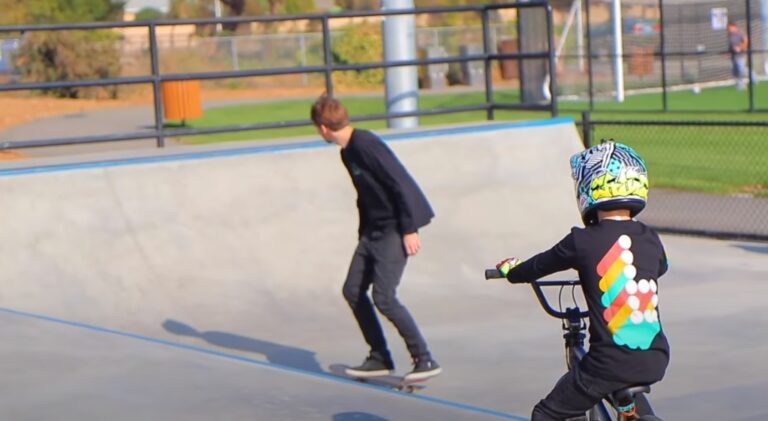BMX and skateboarding have a lot in common. Both activities can be enjoyed by people of all ages, both require a certain amount of skill and coordination, and both can be done almost anywhere.
However, there are also some key differences between BMX and skateboarding. Here’s a look at some of the most notable ones.
BMX vs Skateboarding
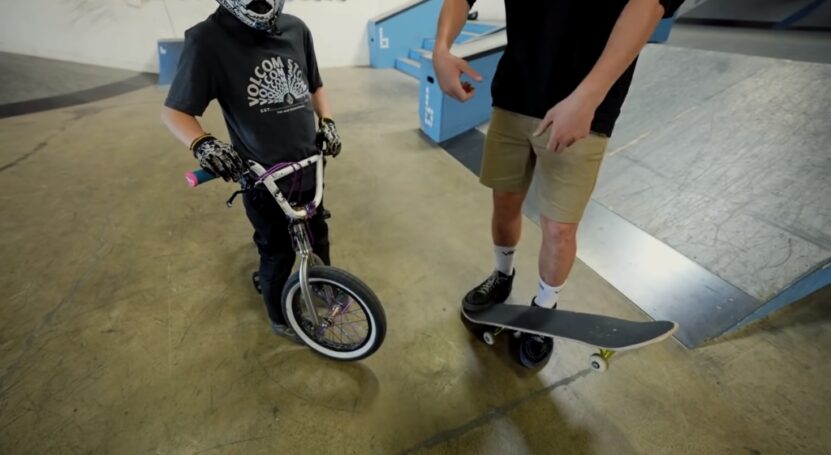
BMX is typically done on dirt tracks, while skateboarding is done on pavement. BMX also requires more speed and agility, while skateboarding requires more balance and coordination.
For starters, BMX tends to be more of a competitive activity than skateboarding. While skateboarding can be competitive, it is often more of an individualistic activity. BMX racing, on the other hand, is a very popular competitive sport. There are also many competitive BMX freestyle events.
Another key difference is the equipment used. Skateboards are, of course, much smaller than BMX bikes. This means that skateboarders often have an easier time maneuvering in tight spaces.
BMX riders, on the other hand, can utilize the size and power of their bikes to perform bigger tricks and jumps. Finally, BMX and skateboarding cultures are quite different. Skateboarding has roots in surfing and was originally developed as an alternative to surfing when the waves were flat.
As such, the culture around skateboarding tends to be more laid-back and easygoing. BMX culture, on the other hand, is often more aggressive and intense. Both sports have their pros and cons, but in the end, it really comes down to personal preference.
Here’s a look at both sides of the argument:
BMX
Pros:
- BMX is a very versatile sport. You can ride on the street, in the park, or even in the dirt.
- BMX bikes are generally more durable than skateboards, so you don’t have to worry about them breaking as easily.
- BMX riders have more control over their bikes, which can be helpful when doing tricks and stunts.
Cons:
- BMX can be expensive, especially if you want a high-end bike.
- BMX bikes are heavier than skateboards, so they can be more difficult to transport.
- BMX riding requires more upper body strength than skateboarding.
Skateboarding
Pros:
- Skateboarding is a very accessible sport. You can skate almost anywhere, and you don’t need a lot of expensive gear to get started.
- Skateboards are relatively light and easy to carry around, so they’re great for travel.
- Skateboarding requires less upper body strength than BMX, so it’s a good option for people who are less physically fit.
Cons:
- Skateboards can be difficult to ride if you’re not used to them. It takes practice to learn how to balance and control a skateboard.
- Skateboards are more fragile than BMX bikes, so they’re more likely to break if you fall or do a trick wrong.
- Skateboarding can be dangerous, especially if you’re not wearing the proper safety gear.
So, which is better? BMX or skateboarding? It really depends on what you’re looking for in a sport. If you want something that’s versatile and durable, then BMX is a good choice.
If you’re looking for something that’s easy to learn and relatively safe, then skateboarding might be a better option.
BMX Biking Overview
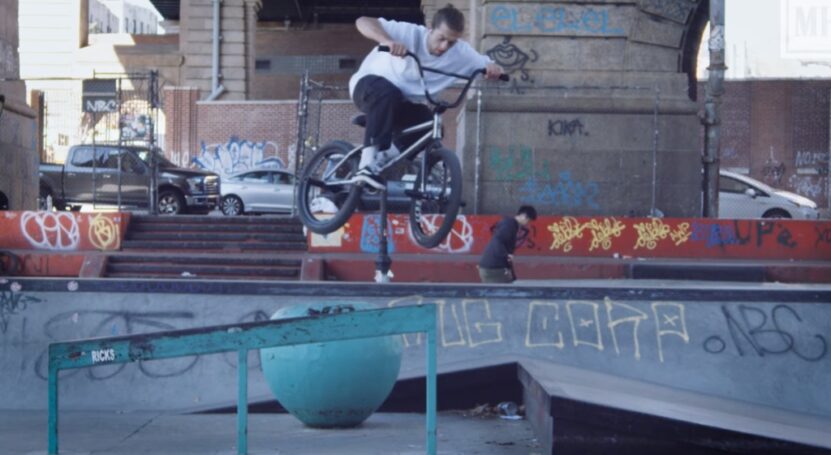
Most people think of BMX as a type of racing, but it is actually much more than that. BMX encompasses many different riding styles, all of which can be divided into two main categories: freestyle and race.
Freestyle BMX includes tricks and stunts performed on ramps, in skateparks, or anywhere else riders can find suitable terrain.
The most popular freestyle disciplines are vert (riding on half pipes and quarter pipes), dirt (jumping and riding on dirt jumps), park (riding on concrete skateparks), street (riding on urban features such as stairs and rails), and flatland (a form of BMX that emphasizes tricks performed on level ground).
Race BMX, as the name suggests, is all about racing. There are two main types of race events: sprints and motos.
Sprint races are short, fast-paced affairs held on purpose-built tracks with tight turns and big jumps. Motos, on the other hand, are longer races held on larger, more open tracks that often incorporate natural features such as dirt, sand, and water.
BMX racing is a great way to get exercise and compete against others, but it can also be a dangerous sport. riders must always wear appropriate safety gear, including a helmet, elbow and knee pads, and gloves.
Skateboarding Overview
Skateboarding is a popular activity among people of all ages, and it’s not just for kids anymore. Whether you’re looking to get some exercise, learn a new skill, or just have some fun, skateboarding is a great option.
There are two main types of skateboards: longboards and shortboards. Longboards are typically longer and wider than shortboards and are better suited for cruising and transportation. Shortboards are smaller and more maneuverable, making them better for tricks and stunts.
Skateboarding is a great way to get exercise, and it’s also a lot of fun. If you’re looking to try something new, or just want to have some fun, skateboarding is a great option.
Riding Experience
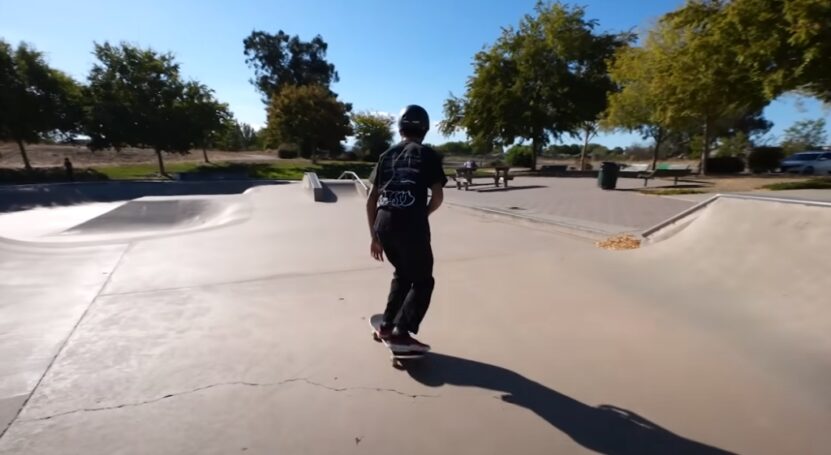
BMX Riding Experience
Whether you’re a beginner or a seasoned pro, BMX riding is an exhilarating experience. There are a few things you should keep in mind before hitting the track, though.
Here are some tips to help you make the most of your BMX riding experience.
If you’re new to BMX riding, start by practicing basic tricks and moves on a smaller scale. A BMX bike is designed for big air and stunts, so it’s important to get a feel for the bike before taking on larger obstacles. Once you’re comfortable with the basics, you can start working your way up to bigger and better tricks.
One of the most important aspects of BMX riding is maintaining your speed. A BMX bike is much lighter than a mountain bike, so it’s easier to get going fast. However, this also means that it’s easier to lose control if you’re not careful. Practice controlling your speed and keeping your balance before taking on more difficult tracks.
As with any sport, there is always a risk of injury when riding BMX. Be sure to wear protective gear, such as a helmet, elbow and knee pads, and gloves. This will help minimize the risk of serious injury if you take a spill. Most importantly, have fun! BMX riding is all about getting out there and enjoying yourself. So get out there and start.
Skateboarding Riding Experience
Whether you’re a beginner or a seasoned skater, there’s always something new to learn about skateboarding. In this article, we’ll share some tips and tricks to help you improve your riding experience.
If you’re just starting out, it’s important to find the right board for you. There are many different shapes and sizes of boards, and each one is designed for a specific purpose. For example, some boards are better for street skating, while others are better for doing tricks. Once you’ve found the right board, it’s time to start practicing.
The best way to learn how to skateboard is by actually getting out there and doing it. Find a local skate park or street spot and just start skating.
Don’t be afraid to fall – everyone falls when they’re learning. And don’t get discouraged if you don’t get it right away. Skateboarding takes practice, so keep at it and you’ll eventually get the hang of it.
As you start to become more comfortable on your board, you can start trying different tricks. There are hundreds of different skateboarding tricks, so you’re sure to find one that’s perfect for you. Once you’ve mastered a few tricks, you can start putting together your own skateboarding routine.
Learning Curve
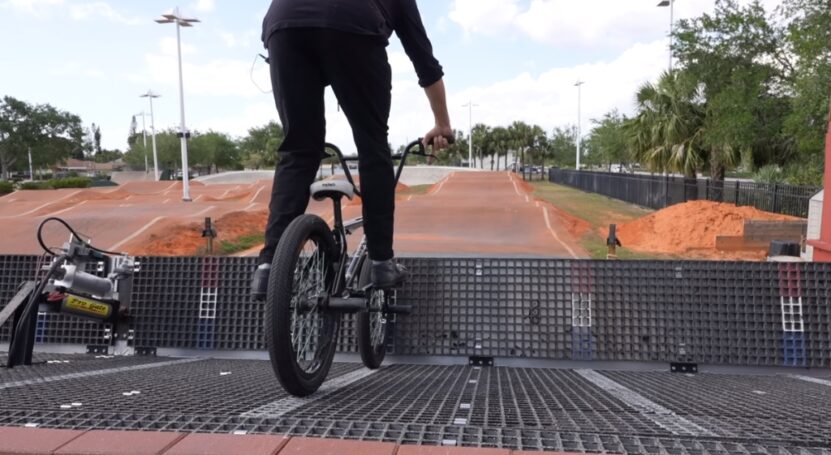
First of all, it’s important to find the right board for you. There are a lot of different types of skateboards out there, and each one is designed for different purposes.
If you’re just starting out, it might be a good idea to get a beginners’ board. These boards are usually wider and more stable, which makes them ideal for learning the basics. Once you’ve got your board, it’s time to start practicing. The best way to learn is by doing, so get out there and start skating!
Try different tricks and see what you can do. It might take a little while to get the hang of things but don’t get discouraged. Just keep at it and you’ll eventually get better. One last thing – don’t forget to wear safety gear! Skateboarding can be dangerous, so it’s important to protect yourself. Always wear a helmet and pads, and be sure to skate in a safe area.
Riding locations
If you’re looking for a great place to ride your BMX bike, here are some locations that are highly recommended. Just remember to always wear a helmet and follow the rules of the road!
The skate park is a great place to start, especially if you’re new to BMX riding. There are usually plenty of other people around to give you tips and pointers, and it’s a great way to get used to handling your bike. Just be sure to stay clear of the skateboarders – they can get pretty territorial!
If you’re looking for something a little more extreme, there are always BMX competitions happening around the country. These are usually open to riders of all levels, so it’s a great way to see how you stack up against the competition. Just be sure to bring your A-game!
Finally, don’t forget that BMX riding isn’t just about tricks and competitions – it’s also about having fun. So get out there and explore your local area on your bike.
Conclusion
So, which sport is better? If you’re looking for a fast-paced, extreme sport, then BMX might be the right choice for you. If you’re looking for a sport that requires more finesse and precision, then skateboarding might be the better option. Whichever sport you choose, you’re sure to have a blast!

